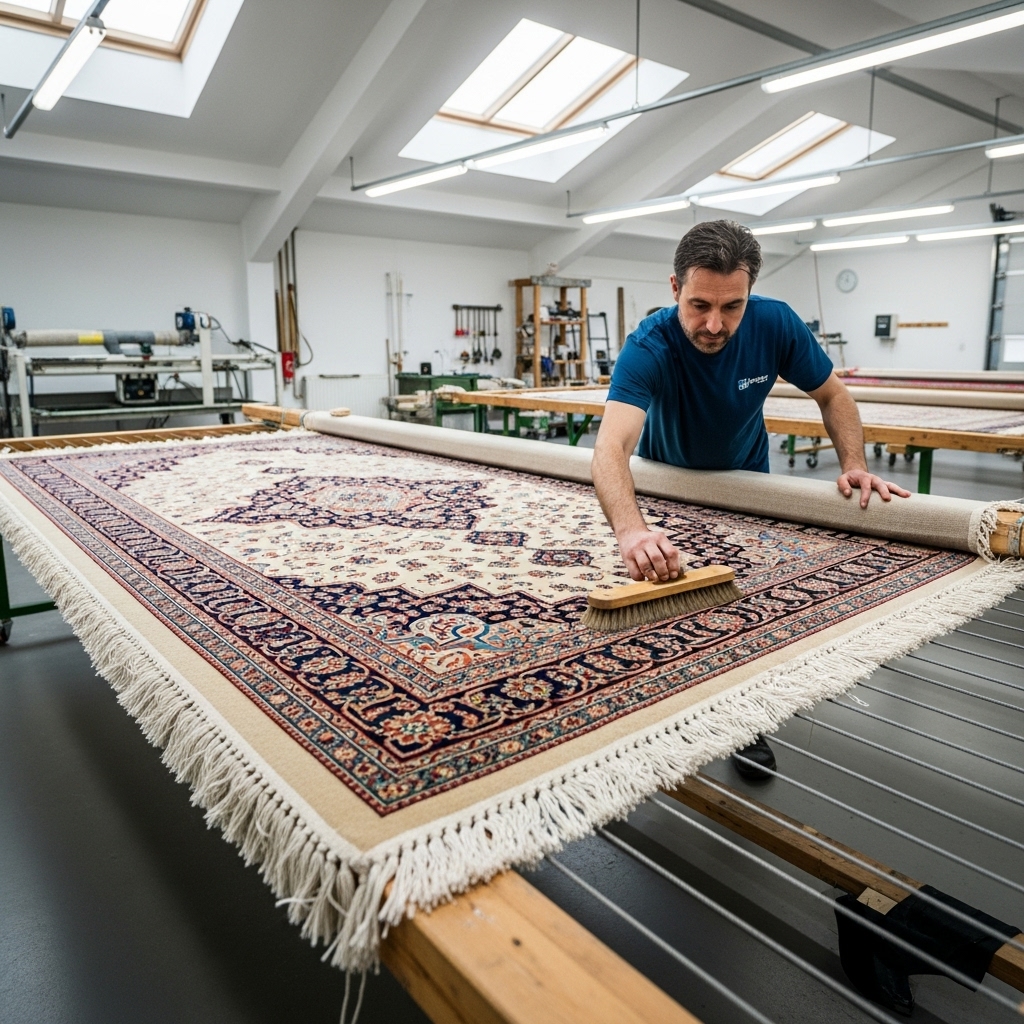Oriental rugs have a way of transforming a room, inviting you to slow down and notice the hand, the color, and the story woven into every knot. In Tampa, we’re lucky to live in spaces that welcome these textiles—from sunny bungalows in Palma Ceia to sleek condos with bay views—yet our coastal climate and easygoing lifestyle ask more of them. Wool and silk pieces absorb the rhythms of daily life and, over time, the residue of humidity, salt air, and fine sand that drifts in from weekend adventures. Professional rug cleaning for Oriental textiles is a specialized craft, and when it’s done with respect for materials and local conditions, the result is a rug that feels alive again.
Every Oriental rug is a language. Wool speaks in resilience and warmth, bending without breaking and reflecting light softly through a fine, natural crimp. Silk answers with glow and precision, offering sharp pattern definition and a luxurious hand that invites a second look. Together, these fibers create depth and nuance, especially in hand-knotted pieces where the weaver’s intention remains visible decades later. To care for them in Tampa is to balance that artistry with practical steps shaped by humidity, sun, and the fine grit that rides home after beach days or boat outings.
Understanding the fibers: wool and silk
Wool thrives under thoughtful care. It is naturally soil resistant and responds beautifully to controlled moisture, which helps release embedded dirt and revives spring. Silk, by contrast, wants gentleness—cooler water, measured agitation, and careful drying to preserve the signature sheen. Many Oriental rugs combine the two, using silk to highlight motifs or borders. That interplay demands a method that protects both fibers at once, which is why a one-method-fits-all approach never suits these textiles.
Construction tells the cleaner what to do
Hand-knotted rugs reveal their structure if you know how to read them. The knot density, foundation materials, and dye system all signal how to proceed. Cotton warps and wefts form a reliable base in many pieces, while older or tribal rugs may include wool foundations that respond differently to water and tension. A careful inspection—checking for migration risks, previous repairs, and weaknesses—precedes any cleaning. The goal is not only to remove soil but to protect the architecture of the rug so it returns home balanced and stable.
The Tampa factor: humidity, sun, and salt air
Our climate introduces three persistent influences. Humidity can linger in dense pile, inviting mustiness if drying is rushed. Bright Gulf light can cause uneven fading if a rug is left in a single orientation for years. Salt aerosol from the bay dulls surface fibers and, combined with airborne dust, contributes to subtle grayness in high-traffic lanes. A professional plan accommodates these realities with deeper dusting, controlled rinsing, and measured drying that reverses dulling without stressing the weave.
Why dusting matters more than you think
Before water ever meets fiber, embedded grit must go. That grit behaves like micro-abrasive when trapped at the base of the pile, gradually cutting fibers and flattening the hand. In Oriental rugs with dense construction, dry soil removal can take time, employing controlled vibration and airflow to coax particles free. Skipping this step or performing it lightly leaves soil to muddy the wash and re-attach to fibers during drying.
Washing practices for Oriental rugs
Every decision during washing reflects testing and inspection. Wool-dominant pieces often benefit from a bath that allows soils to release and float away, paired with a balanced rinse that prevents residues. Where silk appears, the approach shifts to protect luster—cooler water, gentle agitation, and support beneath the rug to maintain shape. The best work is measured, not aggressive, and always open to adjustment as the rug responds in real time.
Rinsing and drying with discipline
Rinsing until the water runs clear is more than a phrase; it’s an outcome you can feel later in the rug’s softness and clarity. Drying follows, with airflow and temperature tuned to fiber and construction. Wool enjoys steady warmth, while silk needs a cooler, calmer environment. Blocking helps relax minor waviness and returns edges to right angles. The discipline here prevents mustiness and preserves the tactile pleasure of a balanced, clean rug.
Fringe and edge care
Fringe is a continuation of the foundation, not decoration, and it deserves respect. Gentle brightening lifts dullness without over-bleaching, which would weaken fibers. Edges receive attention too, as they endure the most friction during everyday use. A tidy binding or minor repair can prevent snags and maintain safety, especially in rooms where chairs move frequently.
Color, abrash, and the soul of the rug
Oriental rugs often feature abrash—subtle shifts in color that come from hand-dyed yarns. Cleaning should clarify those passages, not homogenize them. Testing dyes before washing confirms how they behave so the bath protects character. When handled correctly, you’ll see patterns sharpen and fields glow, with the natural variation intact.
Care in homes and condos
In single-family homes, access is straightforward and larger rugs can be handled with room to spare. Condos layer in logistics—loading docks, elevators, and common-area protection. A Tampa team experienced with building protocols keeps the process smooth and respectful. In both settings, clear communication, careful handling, and tidy placement on return make the difference between a simple service and a considered experience.
Living with your refreshed rug
Once the rug returns, small habits safeguard the results. Use a pad appropriate to the floor beneath, rotate seasonally to even out sun exposure, and vacuum with a beater bar set to match pile height. Blot spills, don’t scrub, and let the rug rest a bit before heavy foot traffic so the pile can settle. In spaces near balcony doors, keep thresholds tidy to intercept grit before it migrates inward.
When restoration is part of the journey
Some Oriental rugs arrive with stories written in thread—an older repair, a gently curling corner, or a narrow section of worn pile on a pathway. After cleaning, these become easier to evaluate. Minor re-knotting, foundation stabilization, or edge binding can be scheduled to protect both beauty and structure. Small, timely interventions preserve value and ensure the rug remains a safe, elegant part of your room.
Why experience with Oriental textiles matters
Not every cleaning method respects the nuance of wool-and-silk construction. A seasoned Tampa professional reads the rug and adjusts in real time, from the first dye test to the final grooming pass. This level of attention reduces risk and elevates results, returning the piece with its character intact and its colors awake again.
The mid-process moments that make the difference
What you won’t see at home—precise pH balancing, controlled agitation, measured rinse volume, and quiet, patient drying—are the elements that deliver a soft hand and crystalline color. That is the heart of expert rug cleaning: an accumulation of careful choices rather than a single dramatic step. When those choices align, the rug feels like itself again, just fresher and truer.
Frequently asked questions
Here are answers to the questions Tampa rug owners ask most often about caring for Oriental wool and silk pieces.
Will cleaning make silk lose its sheen?
Handled correctly, no. Silk’s glow depends on delicate fibers that reflect light in a distinct way. Gentle agitation, cool water, and controlled drying preserve that optical effect, allowing the sheen to reappear clearly once soils are removed.
Can you clean rugs that have older repairs?
Yes, with care. Inspection identifies previous work and any areas that need reinforcement. Cleaning is adjusted to support those spots, and additional stabilization can be planned if the rug would benefit from it.
How do you prevent color migration?
Dye testing guides the method. When colors show sensitivity, the process shifts toward lower moisture, cooler temperatures, and faster, more controlled drying. Rinsing remains thorough but measured, keeping hues where they belong.
Is off-site cleaning better for Oriental rugs?
Almost always. Off-site studios allow full dusting, careful washing, and precise drying conditions, all critical for dense or delicate constructions. In-home methods are typically surface-level and can leave residues that mask soils without truly removing them.
How should I care for my rug between professional visits?
Vacuum routinely with the correct setting, rotate seasonally, and use a pad that fits both your floor and the rug. Address spills promptly with blotting, avoid harsh scrubbing, and check occasionally for moisture in areas near balcony doors or entryways.
When your wool or silk treasure deserves attentive, knowledgeable care, choose a local team that treats every knot with respect. Reach out now to schedule professional rug cleaning and enjoy the renewed glow, softness, and balance that make an Oriental rug the quiet star of any Tampa room.

